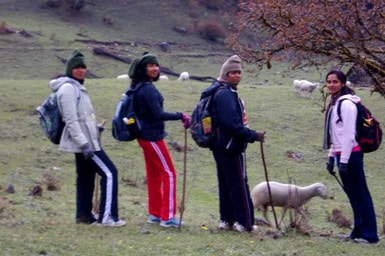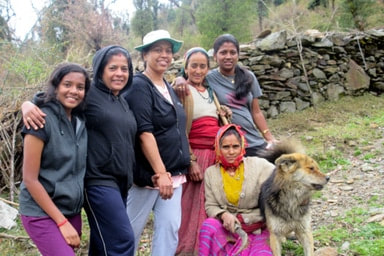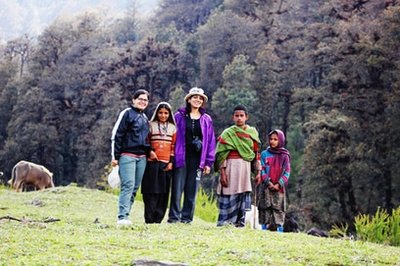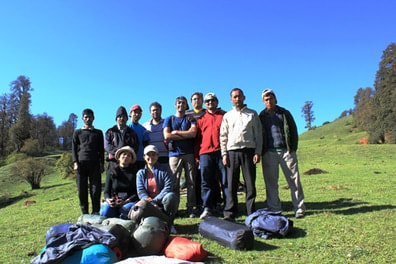Gaumukh & Tapovan trek.
|
* Cover photo: Catching the sunset from Tapovan. Mt Bhagirathi 2, 3 and 1 in the background Copyright: My Himalayan Adventure
|
Difficulty level: Moderate for an experienced trekker, strenuous for a beginner after Gaumukh. The route till Gaumukh is fairly straightforward- gradual with a well marked route and you will be trekking for 4-5 hours a day. But the route between Gaumukh and Tapovan is tricky and tiring- steep patches that go through loose scree areas and the trek takes about 6 hours. Altitude adds to the level of challenge. We advise a high level of fitness and endurance if you plan to trek all the way to Tapovan. You should be comfortable if you get into a fitness routine before this trek. If you dont want to exert as much then you could go till Gaumukh. Happy to give you advice on this.
Is the trek suitable for children? The youngest child to reach Tapovan with us was 13 years of age, but it was challenging for him. We do not recommend Tapovan to children younger than that for reasons mentioned above- terrain and altitude. Even children of that age and elder require additional precautions, need to be monitored and the itinerary customized to ensure their safety and well being. For really small children, we recommend you go up to Gaumukh and not beyond.
Can first time trekkers and/or families do this? Yes you can, but for the reasons mentioned above, it is challenging and will be tiring so please be physically and mentally prepared for a challenge if you plan to go all the way till Tapovan.
No of days required? For Tapovan, we recommend 6-7 days ensuring you give yourself sufficient time to get used to the altitude. Gaumukh can be done in much shorter time. Typically 4-5 days. Happy to help you in customizing this plan based on how many days you have.
Is the trek suitable for children? The youngest child to reach Tapovan with us was 13 years of age, but it was challenging for him. We do not recommend Tapovan to children younger than that for reasons mentioned above- terrain and altitude. Even children of that age and elder require additional precautions, need to be monitored and the itinerary customized to ensure their safety and well being. For really small children, we recommend you go up to Gaumukh and not beyond.
Can first time trekkers and/or families do this? Yes you can, but for the reasons mentioned above, it is challenging and will be tiring so please be physically and mentally prepared for a challenge if you plan to go all the way till Tapovan.
No of days required? For Tapovan, we recommend 6-7 days ensuring you give yourself sufficient time to get used to the altitude. Gaumukh can be done in much shorter time. Typically 4-5 days. Happy to help you in customizing this plan based on how many days you have.
One of the most important glacial regions in the world as it is home to the Gaumukh glacier and the Ganga river. This area has one of the most beautiful climbing routes in the Himalayas and in Hindu mythology, this region is considered to the center of the universe!
-
Details, pics & advice
<
>
|
Region: Garhwal Himalayas in Uttarakhand
Maximum height during the trek: Tapovan is about 14,000 ft, Gaumukh is about 12,500 ft Distance you need to travel by road in hilly areas winding roads: Around 260 km How much will you be trekking in a day: Between 4 to 6 hours on average during the trekking days. Price range for a fixed departure/custom group with 4+ people: Trek cost for the Gaumukh and Tapovan trek is in the range of INR 2500-2800 per person per day with budget facilities, upwards of INR 3000 for more premium facilties that are typically more enjoyable for the not so hardened trekkers. This trek is more expensive in comparison to other others. We have explained the reasons in this page. What to expect: For a large part of the drive and the trek you will be moving along the river Ganga. The initial part of the trek is through very dense forests, which gradually gives way to glacial terrain and rocky scree patches. All along you will be very close to some of the most prominent mountains in the Himalayas and some of the most revered areas in Hindu mythology. Tapovan is a very beautiful meadow and is the base camp for Mt Shivling which is considered to be one of the most beautiful mountains in the world. You will be trekking for 4-6 hours a day. Straightforward till Gaumukh but a little tricky and tiring thereafter. Things we love about this trek: This route has some of the most beautiful climbing routes in the Himalayas, this is one of the most important glacial regions in the country being the home of the Gaumukh glacier and source of the Ganga river, this is also considered to be the center of the universe according to Hindu mythology. Things we don't: Driving time to the trek base is on the longer side. Since it is a protected area, entry beyond Gangotri is restricted and permissions can be expensive. Therefore, the costs on this trek are on the higher side. We have touched upon the tricky terrain and altitude. Unfortunately, over the last 20 years we get heartbroken every time we visit this region due to the rapid rate at which the Gaumukh glacier is receding. Can't exactly term this as a drawback of the trek since we humans are responsible for it. But looking at the glacier for what it was and what it now is makes us sad every time. View our upcoming treks this season, click here Want a customization? Call/email us or drop a message in the chat box below, we'll get back to you right away Our thoughts: The internet is flooded with clichés related to travel. One of those quotes that come to our mind during this trek is: “travel leaves you speechless, and then turns you into a story teller”. We find speechlessness as a common reaction among our clients when after long hours of toil on a 60 degree incline, the trail suddenly flattens out to reveal the vast meadows of Tapovan and the majestic Mt Shivling that is considered by many to be one of the most beautiful mountains in the world. Anyone and everyone- from those who have never been to the Himalayas before to the seasoned climbers and trekkers are happy to admit that this is nothing like they have ever seen before- the grandeur of Mt Shivling and its dominating vertical ridge lines straight ahead. Mt Meru and the Shark’s fin just behind it. Everywhere else that you look, there is a prominent mountain whose slopes and ridges have numerous stories to tell. Trekking to Tapovan and then possibly ahead to Meru base camp is not easy. For this trek you will be trekking for long hours- anywhere between 4-6 hours a day. The trail between Gaumukh and Tapovan is not only very steep, but also tricky with loose patches that require expert leaders to negotiate. But we have never had a client who has said the hardship was not worth it. All their effort and all their aches turned into joy the moment Tapovan revealed itself. As we have also mentioned previously, the Gangotri- Gaumukh region is one of the most revered regions in the Hindu religion as the river Ganga descended from heaven to earth here. Since the Ganga River is one of the most important rivers in India, its source is naturally of high importance. Meru parvat is also considered to be the centre of the universe in Hindu scriptures. The Gangotri temple is one of the four Dhams here and is visited by millions every year. For the Gaumukh/ Tapovan/ Meru Base camp trek, you will be trekking between 4-6 hours a day on average. The trail on the first day goes to Chirwasa from Gangotri. Starting at 10,000 ft. and ending the day at 11,000 ft. Chirwasa is known so because it is lined with Chir (Pine) trees. The trail is well marked and gradual. The next day you cross Bhojwasa, known so because it is lined with Bhojpatra trees. Paper in the old times was made from these trees. The terrain is similar- gradual and well-marked. Gaumukh is called so because at one point in the not so long past it had a snout that was about 20 feet tall and therefore the glacier resembled the mouth of a cow (Gau stands for cow in Hindi and Mukh stands for mouth). |
A timelapse of the sunset on the Bhagirathi range from Tapovan (click to play)
|
Scroll below for more info or get in touch with us to plan this
|
|
Trekking with
|
|
Typical Tapovan itinerary:
This is an indicative itinerary for the Tapovan trek that we run on our fixed departures, customized with the assumption that you are physically active. There is a routine that we could guide you with that will get you in good physical shape. There are other iterations to this itinerary in case you want sometime easier or if you want something more challenging. You can add a day to this to go closer to Meru Base camp, add another day to go to Nandanvan- Bhagirathi 2 base camp etc. If you have never trekked before and want to go till Tapovan then we will recommend adding an extra day to this itinerary for acclamatization at Bhojwasa because you will be rapidly touching high altitude after that. Happy to guide you on this, do speak to us if you are interested in such customizations. Day 1: Drive to Gangotri (3,100 m/10,200 ft): 250 km/8-9 hour drive For a large part of this trek, we will be following the river Bhagirathi up to its source. For the first day, a large part of the drive will be along the banks of this sacred river. The road is twisty and windy but very beautiful. Spend the night in the holy town of Gangotri in a hotel along the banks of this river. Day 2: Trek from Gangotri to Bhojwasa (3,775 m/12,385 ft): 14 km/5-6 hour trek Follow the river Bhagirathi further up to its source and camp for the night 5 km before the source at Bhojbasa. The trek is fairly gradual along a well-made path frequented by trekkers and pilgrims alike looking at reaching the source of the Ganges and beyond. Night camping in Bhojbasa. The trek offers beautiful views of some of the most beautiful and prominent peaks in the Garhwal Himalayas including the Bhagirathi range, Sudarshan Parvat, Thelu to name a few. Day 3: Trek from Bhojwasa to Tapovan (4,463 m/14,640 ft): 10 km/5-6 hour trek Trek 5 km till Gaumukh (4,023 m/13,200 ft) along a well-made path. After Gaumukh we begin a steep and relatively tougher ascent along glaciers and moraines to reach Tapovan. Tapovan is the base camp of Mt Shivling- considered to be one of the most beautiful peaks in the world and referred to by foreign climbers as the Matterhorn of the east. Tapovan itself is a very beautiful green grassy area overlooking the prominent glaciers that eventually lead to the Bhagirathi river. On the other side we can see the majestic Shivling stand tall and behind it the shark’s fin- Meru Parvat. Day 4: Trek towards either Meru Base camp or do some height gain towards Mt Shivling that makes for an excellent vantage point Use this day to either trek ahead towards Meru Base camp, or trek up as far as possible on the ridge of Mt Shivling that works as a really good vantage point. If you do not want to exert too much then you could also use this day to take it easy at Tapovan- have a chai and chill with the local babas. You could also get introduced to a little bit of rock climbing and snow craft as we normally carry that equipment with us during this trek to give basic training to people. Day 6: Trek back to Chirvasa Day 7: Back to Gangotri, drive back to Uttarkashi Day 8: Back to Dehradun |
Trek Advice for the Gaumukh & Tapovan trek
1) Popularity:
For reasons we have mentioned above, the Gangotri region is quite popular. Gangotri temple is frequented my numerous pilgrims so you are likely to find traffic while driving there. Some of these pilgrims also like going to Gaumukh. Because there are so many climbing trails, the route sees a lot of fellow trekkers and climbers.
If you want a trek which feels more raw where you find few other people, then there are other treks that we can recommend to you as this may not be the ideal choice in that case.
2) Cost & restrictions:
Because the ecology of the Gaumukh region had started to get affected by excessive commercial and tourist activity, about 10 years ago the government introduced restrictions in the region to try and reverse the damage caused. Some of these included restricting the number of people to not more than 150 a day, prior permissions for which had to be taken from the DFO in Uttarkashi, a charge for everyone entering the money from which will be used for improving the ecology.
Because of these reasons, prior permission needs to be taken well in advance if you plan to go in season and because the entry and permissions are more expensive that other treks, this trek ends up being more expensive than other treks.
In addition, ponies don’t go beyond Gaumukh and to go to Tapovan we need to take porters. Porters carry less than ponies, we need to pay for their permissions, their food and stay.
All these total up to significantly higher costs in comparison to other treks.
3) Landscape:
This trek has glaciers, meadows and snow. You won’t find dense forests as such nor will you find too many rural villages. Depending on what aspects of a trek you like you can choose which trek you would like to go for. Happy to help in providing guidance to you.
4) Training and fitness:
Please make sure you are fit by the time you come for this trek. As we have mentioned before, the patch between Gaumukh and Tapovan is steep and tricky which requires physical and mental strength. Which our staff will make sure you are never in any danger, you will find that it isn’t easy going. Altitude adds to the level of difficulty as you are in high altitude. We will constantly monitor you during the trek for any adverse effects of high altitude. There have been rare occasions when we have asked clients who are not coping too well with the fatigue and altitude to stay back or return. This is done for their own safety and we expect the clients to respect the decision of our trek leaders.
5) Good time to do this:
The best times to do this are the months of May, first two weeks of June, October and first two weeks of November. The other times are either closed, too cold or too rainy to be a good experience in our opinion.
1) Popularity:
For reasons we have mentioned above, the Gangotri region is quite popular. Gangotri temple is frequented my numerous pilgrims so you are likely to find traffic while driving there. Some of these pilgrims also like going to Gaumukh. Because there are so many climbing trails, the route sees a lot of fellow trekkers and climbers.
If you want a trek which feels more raw where you find few other people, then there are other treks that we can recommend to you as this may not be the ideal choice in that case.
2) Cost & restrictions:
Because the ecology of the Gaumukh region had started to get affected by excessive commercial and tourist activity, about 10 years ago the government introduced restrictions in the region to try and reverse the damage caused. Some of these included restricting the number of people to not more than 150 a day, prior permissions for which had to be taken from the DFO in Uttarkashi, a charge for everyone entering the money from which will be used for improving the ecology.
Because of these reasons, prior permission needs to be taken well in advance if you plan to go in season and because the entry and permissions are more expensive that other treks, this trek ends up being more expensive than other treks.
In addition, ponies don’t go beyond Gaumukh and to go to Tapovan we need to take porters. Porters carry less than ponies, we need to pay for their permissions, their food and stay.
All these total up to significantly higher costs in comparison to other treks.
3) Landscape:
This trek has glaciers, meadows and snow. You won’t find dense forests as such nor will you find too many rural villages. Depending on what aspects of a trek you like you can choose which trek you would like to go for. Happy to help in providing guidance to you.
4) Training and fitness:
Please make sure you are fit by the time you come for this trek. As we have mentioned before, the patch between Gaumukh and Tapovan is steep and tricky which requires physical and mental strength. Which our staff will make sure you are never in any danger, you will find that it isn’t easy going. Altitude adds to the level of difficulty as you are in high altitude. We will constantly monitor you during the trek for any adverse effects of high altitude. There have been rare occasions when we have asked clients who are not coping too well with the fatigue and altitude to stay back or return. This is done for their own safety and we expect the clients to respect the decision of our trek leaders.
5) Good time to do this:
The best times to do this are the months of May, first two weeks of June, October and first two weeks of November. The other times are either closed, too cold or too rainy to be a good experience in our opinion.



















